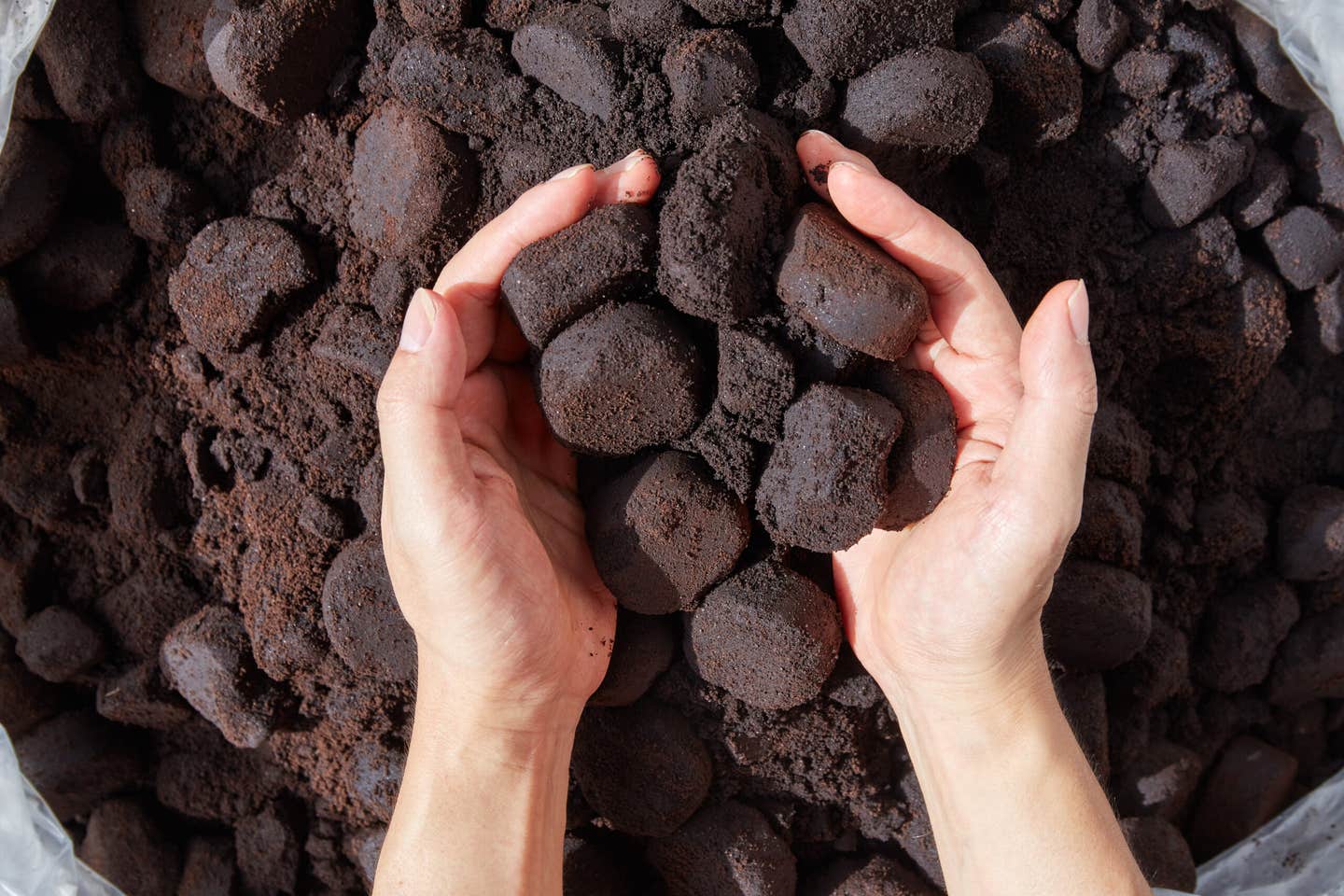Scientists use coffee and plastic waste to brew up a new way to capture carbon
Scientists turn coffee waste and plastic into a low-cost, high-performance material that captures carbon dioxide to fight climate change.

A new patent transforms spent coffee grounds and plastic waste into a sustainable, low-cost material that captures CO2. (CREDIT: Shutterstock)
Every cup of coffee you drink could be purifying the air soon. Researchers at the University of Sharjah have developed a patented technology that transforms used coffee grounds and plastic bottles into an advanced carbon material capable of capturing carbon dioxide (CO₂) before it enters the atmosphere.
Carbon dioxide is a significant driver of global warming, and factory, vehicle, and electricity generation emissions are turbo-charging the climate crisis. Traditional carbon capture methods are often reliant on high-cost materials or high-energy processes. Not so with this new technology, however—which does the opposite by using abundant waste materials and low-energy production to create a high-performance carbon adsorbent.
Waste to Worth: Coffee and Plastic Get a New Lease on Life
Globally, more than 8 million tonnes of used coffee grounds are wasted every year, releasing methane and other greenhouse gases as they decompose in landfill. Polyethylene terephthalate (PET), the plastic used in food packaging and water bottles, is also adding to the world's rapidly growing waste issue. The process developed by the Sharjah group gives both materials a second life.
By combining the PET and coffee grounds with potassium hydroxide (KOH), the scientists created a feedstock that, when heated to temperatures below 700°C, yields activated carbon—a highly porous substance with a high affinity for CO₂ molecules. Not only does the process capture noxious emissions, but it also keeps tons of waste from entering landfills.
What begins with a Starbucks coffee cup and an empty plastic water bottle can become a powerful tool in the fight against climate change," Dr. Haif Aljomard, the lead inventor of the newly patented technology, said.
Cleaner Chemistry and Lower Costs
It uses co-pyrolysis, a thermal process that breaks down plastic and organic materials at relatively low temperatures. Traditional processes for producing activated carbon typically run above 800°C and involve long reaction times. By comparison, the system operates at a much lower and more energy-efficient 600°C.
The trick lies in the synergy between the lignocellulosic structure of coffee and the PET polymer backbone. When mixed in the right proportions—typically somewhere between 1:3 and 3:1—the materials enhance each other's porosity, resulting in activated carbon with a significantly larger surface area. This makes it far more effective at trapping CO₂ than existing materials.
The activated carbon generated is capable of absorbing more than 8 millimoles of CO₂ per gram at standard temperature and pressure, beating the performance of most existing capture materials. These properties make it a prime candidate for industrial carbon capture at large scales, especially where sustainability and cost are significant factors, according to the team.
A Circular Approach to Climate Technology
Professor Chaouki Ghenai, co-inventor and Sustainable and Renewable Energy expert, said the novelty is the circular economy in action. "Transforming waste coffee grounds and plastic into high-quality activated carbon has economic, social, and environmental worth," he said. "Through carbonization and chemical activation, we prevent landfilling these waste materials and spare the environment from their negative effects."
By transforming waste into a precious industrial commodity, the technology closes two waste loops—organic and plastic—while addressing one of the globe's greatest challenges: reducing greenhouse gas emissions.
Far-Reaching Applications Beyond CO₂ Capture
Although the patent addresses CO₂ capture, the material itself has far greater applications. Its chemical stability and high surface area make it perfect for application in numerous industries, ranging from clean energy to water purification.
Professor Ghenai detailed that the activated carbon can be used for the removal of impurities in drinking water systems, wastewater treatment, and filtration of industrial exhaust. Its applications vary from gas purification, groundwater remediation, air and exhaust purification, to even food processing. "This invention can help industries cut emissions, purify air, and recycle waste—all in one process," he added.
The technology could also find application in flue gas treatment at power plants, solvent recovery, and chemical production, providing a versatile technology that can contribute to global sustainability goals.
From Lab to Industry
The patent application was filed on March 2025. As the technology moves to industrial testing, the researchers are optimistic about taking it to the commercial scale. The comparatively low cost of the raw materials utilized—coffee waste, PET plastic, and potassium hydroxide—renders the process feasible for large-scale implementation, especially in nations that produce enormous amounts of coffee and plastic wastes.
Dr. Aljomard noted that the economic and environmental advantages come together. "This invention recycles two abundant waste streams to produce a high-performance material," she said. "It's a step toward greener manufacturing and cleaner air.".
The scientists predict future collaboration with industry to put the material into practice in existing carbon capture and purification systems. If adequately invested in, it could become a flagship technology for power generation and heavy industry, reducing some of the world's most polluting industries' carbon footprint.
Practical Implications of the Research
The new CO₂ capture method can revolutionize how industries treat waste and emissions. By using coffee and plastic waste, it offers a dual environmental benefit—reduced landfill waste and carbon capture before it reaches the atmosphere. The low energy requirement and accessibility of raw materials make it an ideal solution for developing nations in search of affordable climate technologies.
Its promise of application in water filtration, air purification, and industrial filtration also translates to cleaner cities and healthier water sources. Amidst tightening international regulations on emissions and waste disposal, such innovations could help industries meet sustainability goals while minimizing operational costs.
In the long run, this research promises a future where everyday waste is a building block for a cleaner world.
Related Stories
- Researchers turn coffee waste into a weapon against Alzheimer's disease
- Solvent-based recycling and AI could be the key to solving plastic waste
- Worldwide increase in plant CO2 capture signals major climate shift
Like these kind of feel good stories? Get The Brighter Side of News' newsletter.
Shy Cohen
Science & Technology Writer



